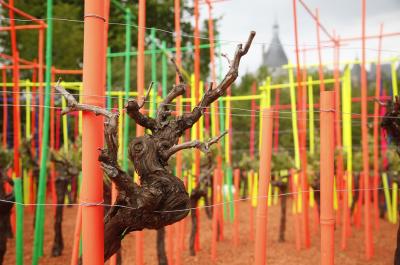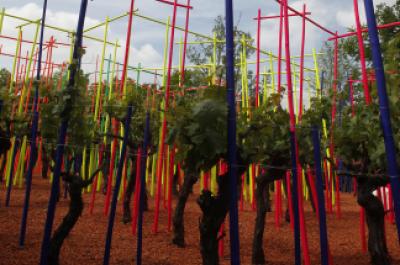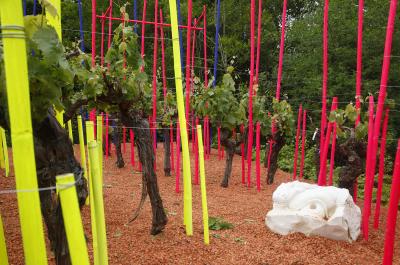04BIS. Le Labyrinthe de la Mémoire
Green card given to Anne and Patrick Poirier
In the rich archives on the subject of the Grounds, the researchers found several documents (mainly written), which vouched for the presence of a maze on a site close to the Château, not far from the Valley of Mist.

Amongst these, on a loose sheet of paper in poor condition, there was something which they interpreted as the plan of the maze: an elliptical chart that resembled the shape of a brain in geometrical form, drawn in several colours.
In the margins these indications were noted:
DREAM – FORGETFULNESS / NIGHT / DARK BLUE
EMOTIONS – PASSIONS / HEART / BLOOD / RED
OBSERVATION – EXPERIENCE – REASON / NATURE / GREEN
INTUITION / GOLD / YELLOW
IMAGINATION – CREATION – SPECULATION / SKY / AZURE
Was this a symbolic plan of the psyche? This hypothesis was confirmed by the discovery (at the top of the sheet) of a title (in Latin) that had been almost completely erased, in beautiful block capitals: LABYRINTHUS MEMORIAE
Other enigmatic scribblings (in Latin) were deciphered on the same manuscript: VIA RUPTA / IN VINO VERITAS / VITIS VITAE ARBOR
The use of Latin and the characteristics of the writing enabled them to date it as a 16th century manuscript, but they got lost in conjectures about the meaning of these clues, with the Maze being one of the oldest and most universal of archetypes in human thought, since the representation of this crisscrossing of dead-ends (Via Rupta) can be found in cultures that are as far removed from one other in time and space as that of the Celts (mazes in Ireland and Galicia), the Cretans (King Minos’s Palace), the Greeks (myths of Daedalus and Theseus), the Egyptians (the Egyptian Maze described by Herodotus), the Etruscans, the Romans (the den of the Sibyl of Cumae described by Virgil in the 6th book of the Aeneid), not to mention the mazes of Christian cathedrals. It is also found in poetic and literary form in the famous book of Persian tales, 1001 Nights, which is nothing other than an infinite journey into a maze of inextricable tales (for example the description of the Palace with a hundred doors from the 61st night), and, closer to us, in Robbe-Grillet or Borgès.
A mental figure that has become a space, a mental space that has become visible and penetrable, over the ages the Maze has inspired huge quantities of artistic and architectural creations, especially in mannerist and classical gardens, to which this LABYRINTHVS MEMORIAE, which we are talking about here, seems to belong.
Soundings were undertaken, complicated by the fact that numerous ornamental gardens had regularly been created in this area of the Grounds. And by carefully uncovering the various layers of earth during core samplings carried out at various points in one plot, the archaeologists found the traces of the Maze. Its plan was in fact, in accordance with the document in the archives, like the geometrical convolutions of a brain, inside which the walker could wander and lose himself. At the centre of the excavation site, they unearthed a large, rather disturbing EYE. The eye of the Minotaur?
The Management of the Domaine undertook the reconstruction of the Brain-Maze on its original site. It was decided, so as to respect the indications in the manuscript (IN VINO VERITAS, and VITIS VITAE ARBOR), to plant vines there and to indicate the zones of this poetic metaphor of the soul with different colours.
DESIGNERS

Anne Poirier was born on 31 March 1941 in Marseilles and Patrick Poirier on 5 May 1942 in Nantes. They now live at Lourmarin in Vaucluse. After studying at the Paris Decorative Arts School, they were resident artists at the Villa Médicis from 1967 to 1972. Right from the start of their time there, they decided to work together and to pool their ideas and sensitivities.
Anne and Patrick Poirier are true travellers through memory, which they consider to be the basis of all intelligence between human beings and societies. They explore sites and remains from ancient Greek, Roman, Mayan and Indian civilisations and bring them back to life through models and reduced scale reconstitutions. They are sculptors, architects and archaeologists, all at the same time. They are interested in the psyche and continuously strive to understand its structures through a variety of metaphors.
Their installations of models of ruined archaeological sites, the gigantic collapsed sculptures, the herbariums and prints, and the photographs establish paradoxical fictions, which have won these artists international recognition since the start of the 1970s. In 1984, they carried out a public commission for the Suchères service area on the Clermont-Ferrand - Saint-Etienne motorway, “The Great Black Column”. This monumental column, collapsed on the ground (100 metres long by 15 metres high) is in fact an anti-monument, a vast Vanity, which denounces the derisive nature of powers and the fragility of empires. This was followed by numerous anti-monuments spread all over the world, in the form of proud monuments reduced to a ruined state: in 1992, another broken column in Toronto, Canada, “Memory of the Future”, in Prato, Italy, a dislocated column was frozen as it fell: in 1996, they were invited by the Research Institute of the Jean-Paul Getty Museum in Los Angeles to organise an exhibition which they called “The Shadow of Gradiva”, where they blended their personal creations with the Museum’s collections, an exhibition where they highlighted their interest in archaeology as a metaphor of psychoanalysis. In 2007, they exhibited “Reflections of the Soul” at the Alice Pauli Gallery in Lausanne, Switzerland.
Using mythological tales as an inspiration and by exploring real or imaginary cities, the work they create together is a metaphor for time and memory. Past and future are closely intertwined, giving us a picture of the fragility of cultures and human beings.


